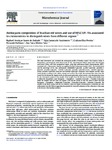Please use this identifier to cite or link to this item:
http://www.alice.cnptia.embrapa.br/alice/handle/doc/958108| Title: | Anthocyanic composition of Brazilian red wines and use of HPLC-UV-Vis associated to chemometrics to distinguish wines from different regions. |
| Authors: | ANDRADE, R. H. S. de  NASCIMENTO. L. S.   PEREIRA, G. E.   HALLWASS   PAIM, A. P. S.   |
| Affiliation: | Raphael Henrique Soares de Andrade, UFPE; Lígia Samara do Nascimento, UFPE; GIULIANO ELIAS PEREIRA, CNPUV; Fernando Hallwass, UFPE; Ana Paula Silveira Paim, UFPE. |
| Date Issued: | 2013 |
| Citation: | Microchemical Journal, New York, v. 110, p. 256-262, abr. 2013. |
| Description: | This study determined and correlated the anthocyanin profile of Brazilian tropical (São Francisco Valley in Pernambuco), and temperate wines (Rio Grande do Sul), and temperate Chilean wines (Valle del Colchagua and Central Valley), with their geographical origins, using high performance liquid chromatography (HPLC) combined with a chemometric method, by applying Principal Component Analysis (PCA). The concentrations and the percentage of the nine anthocyanins (delphinidin-3-glucoside, cyanidin-3-glucoside, petunidin-3-glucoside, peonidin-3-glucoside, malvidin-3-glucoside, peonidin-3-glucoside-acetate, malvidin-3-glucosideacetate, peonidin-3-glucoside coumarate and malvidin-3-glucoside coumarate) were obtained and the values varied greatly according to the cultivar, vintage and country. The results demonstrated that wines from Rio Grande do Sul showed the highest levels of anthocyanin glucosides, which served as the discrimination factor for the chemometric analysis of the samples. Wine samples from the São Francisco Valley preferentially seem to follow the biosynthetic route Naringenin > Kaempferol > Cyanidin-3-Glucoside > Peonidin-3-Glucoside, unlike the samples from the other two regions (Chile and Rio Grande do Sul) that seem to follow the route Naringenin > Kaempferol > Delphinidin-3-Glucoside > Petunidin-3-Glucoside > Malvidin-3-Glucoside. The samples of the Syrah variety from the São Francisco Valley had higher concentrations of individual and total anthocyanins than the Chilean, suggesting the potential for successful adaptation of the cultivation of this grape to the terroir of the Brazilian northeast. |
| Thesagro: | Enologia Vinho Análise química Antocianina |
| Keywords: | Malvidina PCA Cromatografia líquida Origem geográfica Região Nordeste Brasil |
| Type of Material: | Artigo de periódico |
| Access: | openAccess |
| Appears in Collections: | Artigo em periódico indexado (CNPUV)  |
Files in This Item:
| File | Description | Size | Format | |
|---|---|---|---|---|
| RahaeletalHPLCvinhosMJ2013.pdf | 519.69 kB | Adobe PDF |  View/Open |









